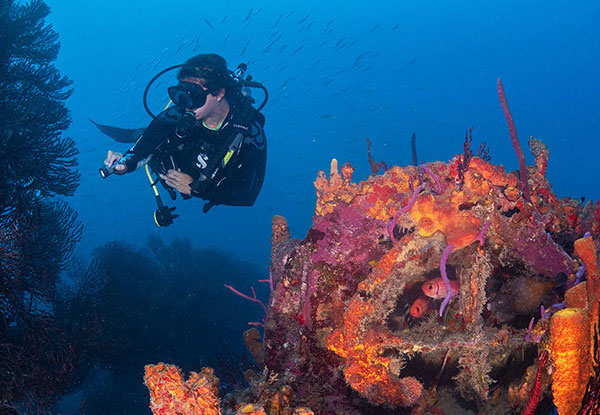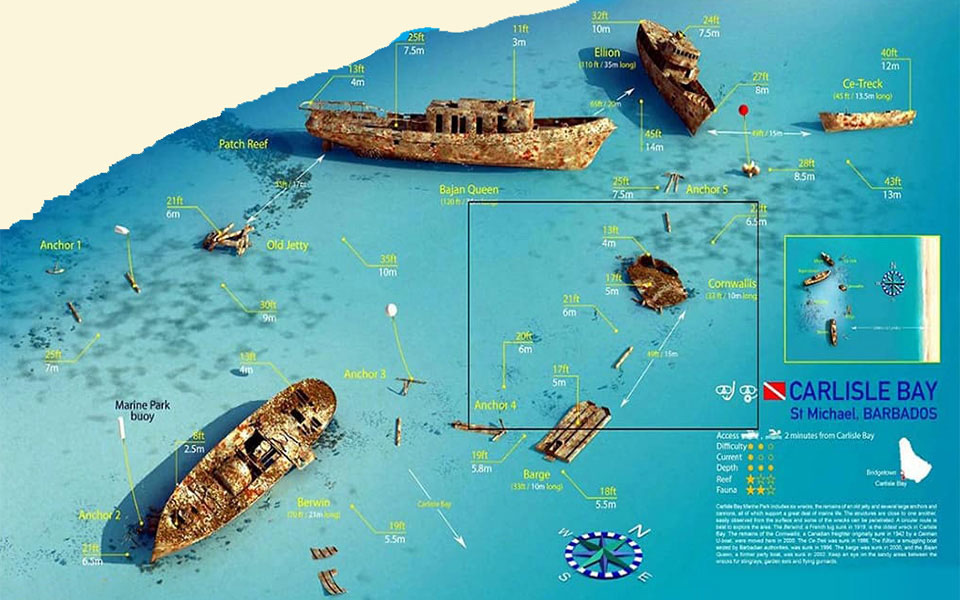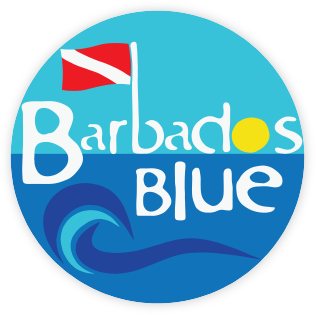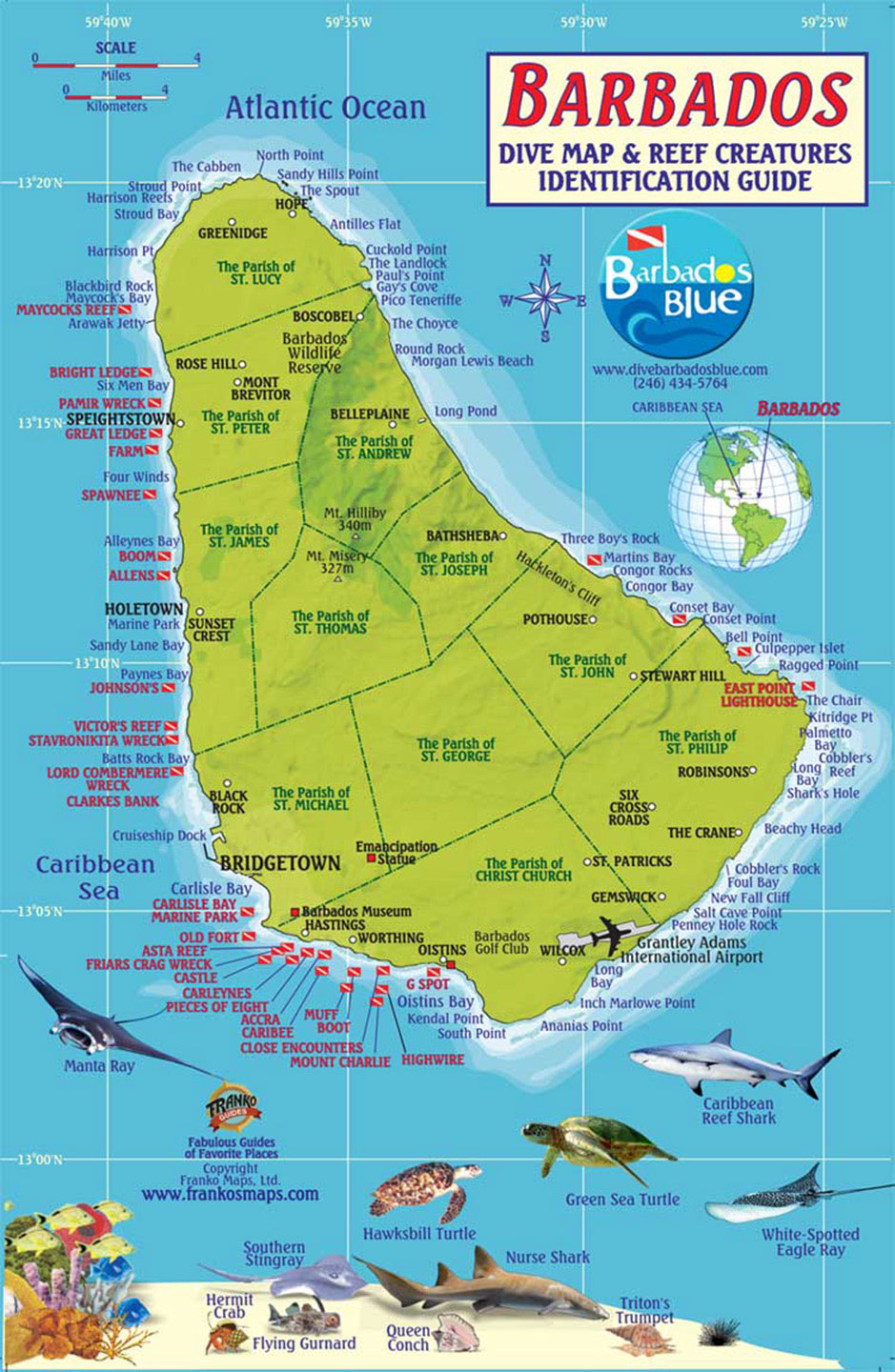Dive Sites
Easy access to all of Barbados’ best scuba diving and snorkeling sites
Ideally located on the southwest corner of Barbados, just south of the Carlisle Bay Marine Park we have easy access to all of Barbados’ best scuba diving and snorkeling sites.

Location Map
Shipwrecks
After the fire, one year went by, and the vessel was still anchored off Carlisle Bay, Barbados. On October 24, 1977, she was purchased at an auction for the sum of $30,000 by the Parks and Beach Commission. The ship was then stripped of all the machinery and brass that could be salvaged. She was cleaned of pollutants, namely the 70,000 gallons of oil being carried in her fuel tanks and towed to a spot just 400 yards offshore on the west coast of the island. On November 21, 1978, the U.S. Navy demolition crew set seven charges totalling 200 pounds and blew holes in the ship’s hull, causing her to sink.
With its 6 shipwrecks in close proximity, this is an excellent site for divers of all levels of experience, from beginner to expert. The great diversity of brilliantly coloured marine life including frogfish, sea horses, rays, barracudas, octopus, reef squid, mackerel, moray eel and more provide more to admire than we have eyes to look upon. The park is roughly marked out underwater by old cannons, anchors and pylons to lead the way from one wreck to the next.

We are very lucky to call this site home and as our house-reef, we are in the park every afternoon at 2 pm. Snorkelers are encouraged to join in. This site is accessible as a shore dive however for convenience and safety sake is done daily by boat.
- BERWYN: Carlisle Bay ~ 20ft ~ A 70 ft long World War I French Tug Boat sunk in 1919 by her own crew. The Berwyn sits between 7 and 10 feet below the surface depending on the tide. As a result of the calm water in the bay and the age of this wreck, the Berwyn is covered in marine
life including healthy hard and soft coral growth and their associated reef creatures. - CE-TReK: Carlisle Bay ~ 45ft ~ The Ce-Trek, a derelict boat constructed of cement was sunk in January 1986. This shipwreck sits in deeper water on the northern edge of the park and is home to nice coral, soft coral and sponge growth.
- EILLON: Carlisle Bay ~ 55ft ~ This 110ft drug boat was tied up for ~6 years in the Bridgetown careenage before it was sunk on 8th June 1996 in Carlisle Bay Marine Park. The wreck is easily accessible for penetration and has an air pocket in the bow big enough for a conversation at 25′ under.
- BAJAN QUEEN: Carlisle Bay ~ 35ft ~ She was Barbados’ first tugboat named the “Pelican” when the Bridgetown Harbour was being constructed in the 1960s. A decade later, as more modern tugboats were purchased; the Pelican was then converted to a party boat called “Bajan Queen”. The Bajan Queen holds many memories for thousands of Barbadians and visitors alike. After years of operation as the party spot, the Bajan Queen was donated to the Coastal Zone Management Unit. From there with the assistance of our very own Andre Miller the Bajan Queen was cleaned up and sunk on 19th May 2002 in Carlisle Bay Marine Park. She now sits only a few feet below the surface and is accumulating some excellent fish life and good coral diversity.
- CORNWALLIS: Carlisle Bay ~15ft ~ A Canadian freighter sunk by a torpedo from a German U-Boat during World War II. This wreck was relocated from a very high boat traffic region of the bay to this Marine Reserve on 22nd October 2003.
- BARGE: Carlisle Bay ~ 12ft ~ A Naval Landing Barge found in Carlisle Bay. This wreck is now home to numerous reef fish including the puffer’s bigger cousin the porcupine fish
Coral Reefs
Shallow barrier reef with lots of small fish life.
Cannonballs and antique bottles can be found on this drift dive.
Deep drift dive, good for photography with lots of fish life.
This inner reef can be done in combination with the wreck Friar’s Craig. Great drift dive with lots of marine life with occasional sightings of stingrays.
A barrier reef with a slow drop off on either side, great for macro photography (lots of barracudas).
A barrier reef with a drop-off on both sides of the reef. Lots of barracudas, snapper and cavalee may be seen on this reef.
This drift dive is good for photography with lots of fish and marine life
Shallow reef dive good for novice divers and photographers. Regular sightings of large schools of Bermuda Chubs on this dive.
Barrier reef great dive for all types of photography, lots of marine life. A drift dive.
Nice drift dive, lots of turtles to be seen on this dive, regular sightings of Eagle Rays. Good marine life, small derelict Coast Guard boat sunk here.
Virgin reef, great fish life (horse-eyes, blackjacks and barracudas) excellent for photography. Home of the famous sponge.
Deep reef dive, outer barrier reef, lots of marine life, turtles, snapper, horseye, and barracuda. An excellent dive for photography.
This reef is between Mount Charlie and Close Encounters. There are underwater cables that are suspended over this reef. Plenty of small creatures can be found and is a great location for photography.
Inner reef that is good for feeding fish and interacting with stingrays, lots of marine life. This reef also has underwater cables passing over it.
This area was anchorage for wooden sailing vessels and the bottom is littered with 18th & 19th-century bottles. You get to keep what you find. Lots of interesting marine life can be found here.
Good dive site, lots of horse-eye, eels & barracudas. Location of the Atlantis Submarine Dives, you may even get to see the Submarine on some dives.
Shallow patch reef, good for novices. This reef has big coral heads, and lots of small tropical fish, usually done after Victors or Stavronikita as a second dive.
This reef is located on the outer side of the Stavronikita. One of the more underrated reefs in Barbados that is not dived on very often. Soft and hard corals combine to make this site very different.
This is a very popular reef, it has beautiful corals, barracuda, bar jacks, yellowtails and turtles that can be found regularly on this dive. You can dive this site on more than one occasion and not be tired of it. One of the more popular dive sites on the west coast.
Barracuda and other small tropical fish are found on this reef. Lobsters can also be found but they are usually hiding in the reef.
A typical west coast reef, well worth a dive as the corals remain as beautiful as ever harbouring all the small reef creatures often missed when you are concentrating on not missing bigger fish. Abundant with soft corals, barrel sponges, tube sponges, and a large variety of schooling tropical fish, barracudas, turtles, parrot fish, and much more. Very consistent conditions make this a popular dive site.
On the Atlantic side of the island, there are about ten (10) different sites available depending on the weather conditions as seas are usually rough. The best times are in the summer months. Plenty of big fish including sharks can be seen here.


